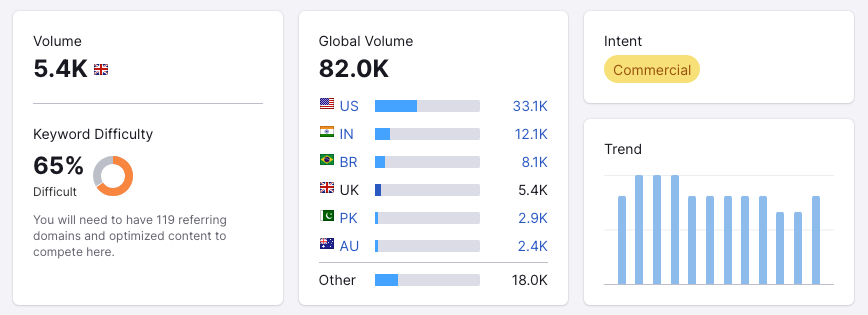Lights, Camera, Rank: The Ultimate Guide to Video SEO Success
Video content has become an essential component of successful content marketing strategies. As online users increasingly prefer to consume information through visual mediums, businesses must adapt by incorporating high-quality videos into their marketing efforts. However, creating engaging videos is only half the battle. To truly stand out in the crowded digital space and reach your target audience, you must also master the art of video search engine optimisation (SEO).
From crafting captivating video titles and meta descriptions to designing eye-catching video thumbnails, we’ll cover all the critical aspects of optimising your video content for search. We’ll also explore the importance of a well-curated YouTube channel, maximising click-through rates on search engine results pages (SERPs), and leveraging social media to amplify your video’s reach.
Video SEO is more than just a buzzword; it’s a powerful approach to boosting your content’s visibility in the ever-expanding world of video search. This guide will provide you with the knowledge and tools to create compelling videos that not only resonate with your target audience but also rank well in search engines. By focusing on targeted keywords, crafting informative video descriptions, and employing the latest ranking factors, you’ll ensure that your videos don’t just get views, but also drive meaningful engagement and conversions.
With the rise of YouTube as the second largest search engine globally, the importance of optimising your videos for search has never been more critical. In the following sections, we will discuss essential techniques to improve your video’s position on SERPs and increase its chances of being a suggested video on platforms like YouTube. Moreover, we’ll show you how to seamlessly integrate your video content into blog posts, social media, and other marketing channels to reach a wider audience.
So, are you ready to watch your video content soar to new heights? Let’s dive into the world of video SEO and unlock the secrets to driving more traffic, engagement, and conversions through your video content.
Book your FREE website MOT today
Keyword Research for Video SEO
Before you begin creating and optimising your video content, it’s crucial to conduct thorough keyword research. This process will help you identify the most relevant and high-traffic keywords that your target audience is searching for, ensuring that your videos have the best chance of ranking well in search engine results.
Identifying Target Keywords
- Brainstorm Potential Keywords: Start by brainstorming a list of potential keywords related to your video’s topic. Think about the questions or queries your target audience might have and the terms they would use to find answers.
- Use Keyword Research Tools: Utilise keyword research tools such as Google Keyword Planner, Ahrefs, Moz, or SEMrush to discover additional keyword ideas and analyse their search volume and competition.

- Analyse Competitor Videos: Investigate your competitors’ video content to identify the keywords they’re targeting. Look at their video titles, descriptions, and tags to gain insights into their keyword strategy.
Analysing Search Intent and Competition
- Determine Search Intent: Understand the intent behind your targeted keywords by examining the SERPs. Are users looking for informational content, transactional content, or something else? Align your video content with the search intent to provide the best value to your audience.
- Evaluate Keyword Competition: Analyse the competitiveness of your targeted keywords by examining the ranking videos on the SERPs. Look at factors such as video quality, view count, engagement, and the authority of the video creators. This analysis will help you gauge your chances of ranking for a particular keyword.
Long-Tail Keywords for Video Content
- Identify Long-Tail Variations: Long-tail keywords are longer, more specific phrases with lower search volume but often lower competition. They are highly valuable for video SEO, as they can help you rank for niche topics and attract a highly targeted audience.
- Leverage Question-Based Keywords: Incorporate question-based long-tail keywords into your strategy, as they tend to align well with informational video content. These keywords often begin with “how to,” “what is,” “why,” or “when.”
- Optimise for Voice Search: As voice search continues to grow in popularity, it’s essential to optimise your video content for voice-based queries. This can be achieved by targeting long-tail keywords that mimic natural language and the way people speak.
With a solid keyword research strategy in place, you’ll be well-equipped to create and optimise video content that appeals to your target audience and ranks well in search engine results. In the next section, we’ll discuss best practices for creating engaging and high-quality videos.
Video Content Creation
Creating engaging, high-quality videos is the foundation of any successful video SEO strategy. To capture your audience’s attention and keep them watching, it’s essential to follow best practices in video production, storytelling, and visual design. In this section, we’ll discuss key aspects of video content creation that will set you up for success.
Choosing the Right Video Format
- Align with Audience Preferences: Choose a video format that resonates with your target audience and best conveys your message. Popular formats include explainer videos, tutorials, product reviews, testimonials, interviews, and live streams.
- Consider Platform Requirements: Different platforms have varying requirements for video formats, lengths, and aspect ratios. Tailor your videos to meet the specifications of the platforms you’ll be using for distribution, such as YouTube, Vimeo, or Facebook.
Scripting and Storytelling Techniques
- Develop a Compelling Storyline: Create a well-structured script that keeps viewers engaged and conveys your message effectively. Focus on storytelling techniques like the hero’s journey, problem-solution scenarios, or case studies to make your content more relatable and impactful.
- Hook Viewers Early: Capture your audience’s attention within the first few seconds by starting with a strong hook, such as a surprising fact, intriguing question, or powerful visual.
- Keep It Concise: Avoid overwhelming your viewers with excessive information. Instead, present your content in a clear, concise manner, breaking it down into easily digestible segments.
Video Production Best Practices
- High-Quality Visuals: Invest in quality video equipment, such as cameras, lighting, and backdrops, to ensure your videos look professional and visually appealing.
- Clear Audio: Use an external microphone and proper recording techniques to capture clear audio, free from distracting background noises or echoes.
- Editing and Post-Production: Edit your video content to create a polished final product. Remove any unnecessary footage, add transitions, and incorporate elements such as graphics, animations, or text overlays to enhance your message.
Engaging Visuals and Sound
- Use Dynamic Visuals: Incorporate a mix of visuals, such as live-action footage, animations, and screen recordings, to keep your content visually engaging and appealing to your audience.
- Add Background Music: Use appropriate background music to set the tone and pace of your video, while ensuring it doesn’t distract from the main content or dialogue.
- Leverage Sound Effects: Use sound effects judiciously to emphasize key points or create a more immersive viewing experience.
By focusing on these crucial aspects of video content creation, you’ll be well on your way to producing videos that captivate your audience and encourage them to take action. In the next section, we’ll explore the techniques for optimising your video content to improve its visibility and search rankings.
Video Optimisation Techniques
Once you have created high-quality, engaging video content, it’s essential to optimize it for search engines and your target audience. Proper optimization will help your videos rank higher in search engine results, increase click-through rates, and drive more views and engagement. In this section, we’ll discuss key video optimization techniques to enhance your video’s search visibility and user experience.
Optimising Video Titles and Descriptions
- Use Targeted Keywords: Include your primary targeted keyword in both the video title and description, ensuring that it appears as naturally as possible. This will signal to search engines the main topic of your video and help improve its rankings.
- Create Compelling Titles: Craft an attention-grabbing title that sparks curiosity and clearly communicates the value of your video. Keep it concise, typically under 60 characters, to avoid truncation in search results.
- Write Descriptive Video Descriptions: Provide a detailed, keyword-rich video description that offers valuable information about your video’s content. This will help search engines better understand your video and improve its chances of ranking for relevant queries.
Effective Use of Tags and Categories
- Utilise Relevant Tags: Add relevant tags to your video that include your targeted keywords and related terms. This will help search engines categorize your video and increase its visibility in search results.
- Leverage Video Categories: Choose the most appropriate category for your video to ensure it reaches the right audience and is associated with similar content on video platforms like YouTube.
Adding Video Transcripts and Captions
- Provide Video Transcripts: Offer a full-text transcript of your video’s audio, either in the video description or on your website. This allows search engines to crawl and index your video’s content, improving its search visibility.
- Implement Captions and Subtitles: Add closed captions and subtitles to your video to make it accessible to a broader audience, including non-native speakers and the hearing impaired. This can also help improve your video’s search rankings by providing additional text for search engines to index.
Creating Custom Video Thumbnails
- Design Eye-Catching Thumbnails: Create custom video thumbnails that are visually appealing and accurately represent your video’s content. An engaging thumbnail can significantly improve your video’s click-through rate and entice users to watch your video.
- Include Relevant Text and Visuals: Incorporate text overlays and relevant visuals in your thumbnail to provide context and emphasize the value of your video. Ensure the text is large and legible, and the visuals are not cluttered.
By implementing these video optimisation techniques, you’ll improve your video’s search visibility, user experience, and overall performance. In the next section, we’ll explore the importance of structured data and video sitemaps in further enhancing your video SEO efforts.
Structured Data and Video Sitemaps
Implementing structured data and creating video sitemaps are essential steps in optimizing your video content for search engines. These techniques help search engines better understand your video content, index it more efficiently, and display it more prominently in search results. In this section, we’ll discuss the importance of structured data and video sitemaps in your video SEO strategy.
Implementing Schema Markup for Videos
- Understanding Schema Markup: Schema markup is a form of structured data that allows you to provide search engines with more detailed information about your video content. By adding schema markup to your video pages, you can help search engines display rich snippets, such as video thumbnails, durations, and upload dates, in search results.
- Choosing the Right Schema Type: Use the “VideoObject” schema type to describe your video content. This schema type allows you to include properties such as name, description, thumbnailUrl, uploadDate, and duration.
- Adding Schema Markup to Your Website: Implement schema markup using JSON-LD, a lightweight and easy-to-implement format. You can either add it directly to your web page’s HTML or use a plugin or CMS feature if your website supports it.
Creating and Submitting Video Sitemaps
- What are Video Sitemaps? Video sitemaps are specialised sitemaps that provide search engines with a list of all the video content on your website. They include information such as video titles, descriptions, durations, and URLs, which helps search engines crawl and index your videos more effectively.
- Structuring Your Video Sitemap: Create an XML sitemap that follows the video sitemap protocol specified by search engines like Google. Ensure that your video sitemap includes essential elements such as video:video, video:title, video:description, video:thumbnail_loc, and video:content_loc.
- Submitting Your Video Sitemap: Once you’ve created your video sitemap, submit it to search engines using their respective webmaster tools, such as Google Search Console or Bing Webmaster Tools. This will notify search engines of your video content and expedite the indexing process.
By leveraging structured data and video sitemaps, you’ll improve your video content’s visibility in search results and ensure that search engines have all the necessary information to index and display your videos accurately. In the next section, we’ll discuss best practices for video hosting and distribution to maximize your video content’s reach and impact.
With these comprehensive insights and actionable tips, you’re now well-equipped to embark on your video SEO journey. By implementing these strategies, you’ll not only improve your video content’s search visibility but also enhance its overall performance and user experience.
Remember, video SEO is an ongoing process that requires continuous optimisation, monitoring, and adaptation. Stay informed about the latest trends and best practices, and keep refining your strategy to ensure your video content remains competitive in the ever-evolving digital landscape.



